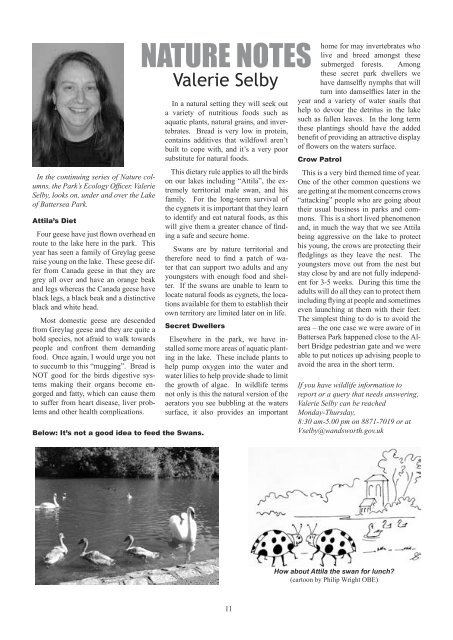Jimmy Burns - Editor Mike Bates - Production - Battersea Park
Jimmy Burns - Editor Mike Bates - Production - Battersea Park
Jimmy Burns - Editor Mike Bates - Production - Battersea Park
Create successful ePaper yourself
Turn your PDF publications into a flip-book with our unique Google optimized e-Paper software.
In the continuing series of Nature columns,<br />
the <strong>Park</strong>’s Ecology Officer, Valerie<br />
Selby, looks on, under and over the Lake<br />
of <strong>Battersea</strong> <strong>Park</strong>.<br />
Attila’s Diet<br />
Four geese have just flown overhead en<br />
route to the lake here in the park. This<br />
year has seen a family of Greylag geese<br />
raise young on the lake. These geese differ<br />
from Canada geese in that they are<br />
grey all over and have an orange beak<br />
and legs whereas the Canada geese have<br />
black legs, a black beak and a distinctive<br />
black and white head.<br />
Most domestic geese are descended<br />
from Greylag geese and they are quite a<br />
bold species, not afraid to walk towards<br />
people and confront them demanding<br />
food. Once again, I would urge you not<br />
to succumb to this “mugging”. Bread is<br />
NOT good for the birds digestive systems<br />
making their organs become engorged<br />
and fatty, which can cause them<br />
to suffer from heart disease, liver problems<br />
and other health complications.<br />
Valerie Selby<br />
Secret Dwellers<br />
Below: It’s not a good idea to feed the Swans.<br />
NATURE NOTES<br />
In a natural setting they will seek out<br />
a variety of nutritious foods such as<br />
aquatic plants, natural grains, and invertebrates.<br />
Bread is very low in protein,<br />
contains additives that wildfowl aren’t<br />
built to cope with, and it’s a very poor<br />
substitute for natural foods.<br />
This dietary rule applies to all the birds<br />
on our lakes including “Attila”, the extremely<br />
territorial male swan, and his<br />
family. For the long-term survival of<br />
the cygnets it is important that they learn<br />
to identify and eat natural foods, as this<br />
will give them a greater chance of finding<br />
a safe and secure home.<br />
Swans are by nature territorial and<br />
therefore need to find a patch of water<br />
that can support two adults and any<br />
youngsters with enough food and shelter.<br />
If the swans are unable to learn to<br />
locate natural foods as cygnets, the locations<br />
available for them to establish their<br />
own territory are limited later on in life.<br />
Elsewhere in the park, we have installed<br />
some more areas of aquatic planting<br />
in the lake. These include plants to<br />
help pump oxygen into the water and<br />
water lilies to help provide shade to limit<br />
the growth of algae. In wildlife terms<br />
not only is this the natural version of the<br />
aerators you see bubbling at the waters<br />
surface, it also provides an important<br />
11<br />
home for may invertebrates who<br />
live and breed amongst these<br />
submerged forests. Among<br />
these secret park dwellers we<br />
have damselfly nymphs that will<br />
turn into damselflies later in the<br />
year and a variety of water snails that<br />
help to devour the detritus in the lake<br />
such as fallen leaves. In the long term<br />
these plantings should have the added<br />
benefit of providing an attractive display<br />
of flowers on the waters surface.<br />
Crow Patrol<br />
This is a very bird themed time of year.<br />
One of the other common questions we<br />
are getting at the moment concerns crows<br />
“attacking” people who are going about<br />
their usual business in parks and commons.<br />
This is a short lived phenomenon<br />
and, in much the way that we see Attila<br />
being aggressive on the lake to protect<br />
his young, the crows are protecting their<br />
fledglings as they leave the nest. The<br />
youngsters move out from the nest but<br />
stay close by and are not fully independent<br />
for 3-5 weeks. During this time the<br />
adults will do all they can to protect them<br />
including flying at people and sometimes<br />
even launching at them with their feet.<br />
The simplest thing to do is to avoid the<br />
area – the one case we were aware of in<br />
<strong>Battersea</strong> <strong>Park</strong> happened close to the Albert<br />
Bridge pedestrian gate and we were<br />
able to put notices up advising people to<br />
avoid the area in the short term.<br />
If you have wildlife information to<br />
report or a query that needs answering,<br />
Valerie Selby can be reached<br />
Monday-Thursday,<br />
8:30 am-5.00 pm on 8871-7019 or at<br />
Vselby@wandsworth.gov.uk<br />
How about Attila the swan for lunch?<br />
(cartoon by Philip Wright OBE)


